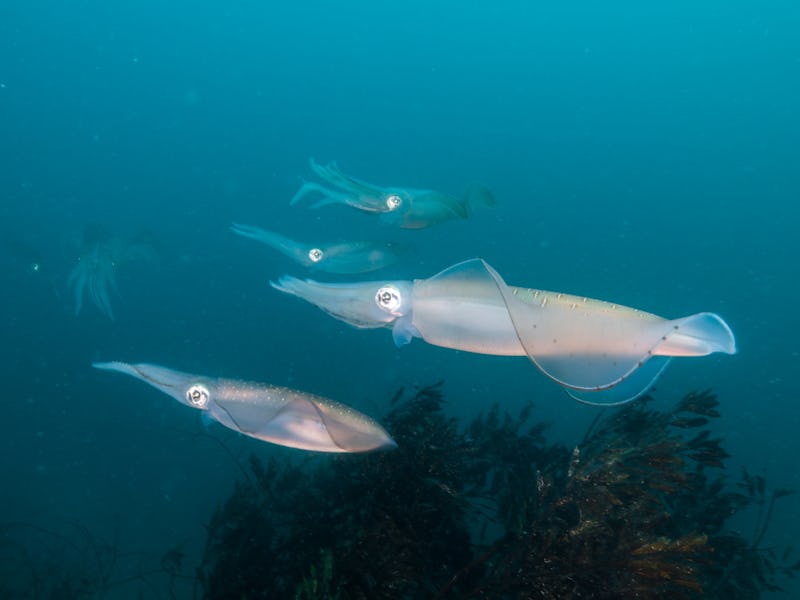This smart sea creature saves room for dessert — study
Cuttlefish offer a lesson in self control that us humans stand to learn from.

We’ve all been there: Stuffed full after a big dinner, sure we will ever eat again. But for some of us (most of us), when the dessert menu comes, it is like our brains go out the window and we make decisions we later regret. New research suggests that the urge to splurge isn't a problem for one smart sea creature, though.
When it comes to exercising self-control, cuttlefish know what’s up.
These intelligent cephalopods are a lesson in portion control. It turns out that not only can they predict whether their favorite foods will be available later on — they will also adjust their diet and eat a smaller portion of less-desirable foods to save room, according to a new study published Tuesday in the journal Biology Letters.
The findings are based on the feeding behavior of twenty-nine European common cuttlefish, Sepia officinalis, aged three to six months. Cuttlefish are both opportunists and preppers — at times, they forage for whatever food is going, while at others, they get picky, chasing after only their favorite foods. But what drives them to switch between the two styles of feeding has remained a mystery.
The new study reveals that what is on the menu may be the key: It appears that cuttlefish toggle between the two feeding styles based on what food is available at the time, and what will be there later. Essentially, they are the ultimate flexitarians.
Cuttlefish are adept at learning patterns. They use their skills to save room for their favorite foods.
Portion control
Cuttlefish eat a varied diet of seafood, but just like you might plump for scallops over oysters every time, they too have their favorite — shrimp.
To work out if their love of shrimp was enough to drive the switch in their feeding style, the researchers posed this question: Would cuttlefish choose not to eat a crummy crab if they knew a sumptuous shrimp was in the near future?
The researchers conducted two experiments that reveal how the animals maximize deliciousness in their diets.
In the first experiment, researchers placed a crab in a tank with a cuttlefish every morning. At the day’s end, they noted whether the cuttlefish had eaten the crab, and, if not, they removed it. Then, they used two different scenarios to study how well cuttlefish memorized patterns. In the first scenario, the cuttlefish received one shrimp every evening. In the second, it received a shrimp at random. (Each cuttlefish went through the process 32 times, 16 times under each condition.)
The second experiment involved larger cuttlefish who got two crabs every morning. Again, the scientists recorded how many crabs the cuttlefish ate every day, and removed the leftovers. Then, they gave the cuttlefish two shrimp every other night. By establishing this pattern, the researchers could test the cuttlefish to see if they refrained from eating the crab on the days that the shrimp were coming — and whether they ate the crab on days when shrimp were not on the menu.
In the first experiment, the cuttlefish switched between selective and opportunistic foraging strategies based on whether their preferred prey would be predictably, or unpredictably, available. The number of crabs the cuttlefish ate during the day dropped when the shrimp were a sure bet — and the animals “quickly shifted from one strategy to the other, when experimental conditions were reversed,” the researchers found.
In the second experiment, the cuttlefish reduced crab consumption only when shrimp would be available that night — suggesting they had learnt that it was worth the wait to hold off.
This knack for flexible eating patterns helps cuttlefish survive and adapt, the researchers write.
“Overall, cuttlefish can adopt dynamic and flexible foraging behaviours including selective, opportunistic and future-dependent strategies, in response to changing foraging conditions.”
There may be a lesson for us humans here: If cuttlefish, with their complex brains and decision-making skills, can make the right choice when it comes to food habits, then maybe we, with our even larger brains and greater cognitive abilities, can choose to pass on seconds and save a little room for dessert. Maybe.
Abstract: Some animals optimize their foraging activity by learning and memorizing food availability, in terms of quantity and quality, and adapt their feeding behaviour accordingly. Here, we investigated whether cuttlefish flexibly adapt their foraging behaviour according to the availability of their preferred prey. In Experiment 1, cuttlefish switched from a selective to an opportunistic foraging strategy (or vice versa) when the availability of their preferred prey at night was predictable versus unpredictable. In Experiment 2, cuttlefish exhibited day-to-day foraging flexibility, in response to what will happen in the proximate future (i.e. preferred prey available on alternate nights). In Experiment 1, the number of crabs eaten during the day decreased when shrimp (i.e. preferred food) were predictably available at night, while the consumption of crabs during the day was maintained when shrimp availability was unpredictable. Cuttlefish quickly shifted from one strategy to the other, when experimental conditions were reversed. In Experiment 2, cuttlefish only reduced their consumption of crabs during the daytime when shrimps were predictably available the following night. Their daytime foraging behaviour appeared dependent on shrimps’ future availability. Overall, cuttlefish can adopt dynamic and flexible foraging behaviours including selective, opportunistic and future-dependent strategies, in response to changing foraging conditions.
This article was originally published on